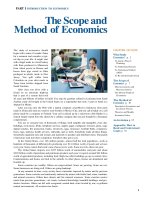The data industry the business and economics of information and big data
Bạn đang xem bản rút gọn của tài liệu. Xem và tải ngay bản đầy đủ của tài liệu tại đây (1.73 MB, 218 trang )
THE DATA INDUSTRY: THE BUSINESS AND
ECONOMICS OF INFORMATION AND BIG DATA
THE DATA INDUSTRY:
THE BUSINESS
AND ECONOMICS
OF INFORMATION
AND BIG DATA
CHUNLEI TANG
Copyright © 2016 by John Wiley & Sons, Inc. All rights reserved
Published by John Wiley & Sons, Inc., Hoboken, New JerseyPublished simultaneously in Canada
No part of this publication may be reproduced, stored in a retrieval system, or transmitted in any form or
by any means, electronic, mechanical, photocopying, recording, scanning, or otherwise, except as
permitted under Section 107 or 108 of the 1976 United States Copyright Act, without either the prior
written permission of the Publisher, or authorization through payment of the appropriate per-copy fee to
the Copyright Clearance Center, Inc., 222 Rosewood Drive, Danvers, MA 01923, (978) 750-8400, fax
(978) 750-4470, or on the web at www.copyright.com. Requests to the Publisher for permission should
be addressed to the Permissions Department, John Wiley & Sons, Inc., 111 River Street, Hoboken, NJ
07030, (201) 748-6011, fax (201) 748-6008, or online at />Limit of Liability/Disclaimer of Warranty: While the publisher and author have used their best efforts in
preparing this book, they make no representations or warranties with respect to the accuracy or
completeness of the contents of this book and specifically disclaim any implied warranties of
merchantability or fitness for a particular purpose. No warranty may be created or extended by sales
representatives or written sales materials. The advice and strategies contained herein may not be suitable
for your situation. You should consult with a professional where appropriate. Neither the publisher nor
author shall be liable for any loss of profit or any other commercial damages, including but not limited to
special, incidental, consequential, or other damages.
For general information on our other products and services or for technical support, please contact our
Customer Care Department within the United States at (800) 762-2974, outside the United States at
(317) 572-3993 or fax (317) 572-4002.
Wiley also publishes its books in a variety of electronic formats. Some content that appears in print may
not be available in electronic formats. For more information about Wiley products, visit our web site at
www.wiley.com.
Library of Congress Cataloging-in-Publication Data:
Names: Tang, Chunlei, author.
Title: The data industry : the business and economics of information and big
data / Chunlei Tang.
Description: Hoboken, New Jersey : John Wiley & Sons, 2016. | Includes
bibliographical references and index.
Identifiers: LCCN 2015044573 (print) | LCCN 2016006245 (ebook) | ISBN
9781119138402 (cloth) | ISBN 9781119138419 (pdf) | ISBN 9781119138426
(epub)
Subjects: LCSH: Information technology–Economic aspects. | Big
data–Economic aspects.
Classification: LCC HC79.I55 T36 2016 (print) | LCC HC79.I55 (ebook) | DDC
338.4/70057–dc23
LC record available at />
Typeset in 10/12pt TimesLTStd by SPi Global, Chennai, India
Printed in the United States of America
10 9 8 7 6 5 4 3 2 1
BIBLIOGRAPHY
The data industry is a reversal, derivation, and upgrading of the information industry
that touches nearly every aspect of modern life. This book is written to provide an
introduction of this new industry to the field of economics. It is among the first books
on this topic. The data industry ranges widely. Any domain (or field) can be called a
“data industry” if it has a fundamental feature: the use of data technologies. This book
(1) explains data resources; (2) introduces the data asset; (3) defines a data industry
chain; (4) enumerates data enterprises’ business models and operating model, as well
as a mode of industrial development for the data industry; (5) describes five types of
enterprise agglomeration, and multiple industrial cluster effects; and (6) provides a
discussion on the establishment and development of data industry related laws and
regulations.
DEDICATION
To my parents, for their tireless support and love
To my mentors, for their unquestioning support of my moving forward in my way
ENDORSEMENTS
“I have no doubt that data will become a fundamental resource, integrated into every
fiber of our society. The data industry will produce incredible value in the future.
Dr. Tang, a gifted young scientist in this field, gives a most up-to-date and systematic
account of the fast-growing data industry. A must read of any practitioner in this area.”
Chen, Yixin Ph.D.,
Full Professor of Computer Science and Engineering, Washington University in St Louis
“Data is a resource whose value can only be realized when analyzed effectively.
Understanding what our data can tell us will help organizations lead successfully and
accelerate business transformation.” This book brings new insights into how to best
optimize our learning from data, so critical to meeting the challenges of the future.
Volk, Lynn A., MHS,
Associate Director, Clinical and Quality Analysis, Information Services, Partners
HealthCare
CONTENTS
Preface
1
What is Data Industry?
1.1
1.2
1.3
2
xix
Data, 2
1.1.1 Data Resources, 3
1.1.2 The Data Asset, 4
Industry, 6
1.2.1 Industry Classification, 7
1.2.2 The Modern Industrial System, 7
Data Industry, 10
1.3.1 Definitions, 10
1.3.2 An Industry Structure Study, 10
1.3.3 Industrial Behavior, 13
1.3.4 Market Performance, 16
Data Resources
2.1
2.2
1
Scientific Data, 19
2.1.1 Data-Intensive Discovery in the Natural Sciences, 20
2.1.2 The Social Sciences Revolution, 21
2.1.3 The Underused Scientific Record, 22
Administrative Data, 22
2.2.1 Open Governmental Affairs Data, 24
2.2.2 Public Release of Administrative Data, 25
2.2.3 A “Numerical” Misunderstanding in Governmental
Affairs, 26
19
xii
CONTENTS
2.3
2.4
2.5
2.6
2.7
3
Data Industry Chain
3.1
3.2
3.3
3.4
3.5
3.6
4
Internet Data, 26
2.3.1 Cyberspace: Data of the Sole Existence, 27
2.3.2 Crawled Fortune, 28
2.3.3 Forum Opinion Mining, 28
2.3.4 Chat with Hidden Identities, 29
2.3.5 Email: The First Type of Electronic Evidence, 30
2.3.6 Evolution of the Blog, 31
2.3.7 Six Degrees Social Network, 32
Financial Data, 33
2.4.1 Twins on News and Financial Data, 33
2.4.2 The Annoyed Data Center, 33
Health Data, 34
2.5.1 Clinical Data: EMRs, EHRs, and PHRs, 34
2.5.2 Medicare Claims Data Fraud and Abuse Detection, 35
Transportation Data, 36
2.6.1 Trajectory Data, 37
2.6.2 Fixed-Position Data, 37
2.6.3 Location-Based Data, 38
Transaction Data, 38
2.7.1 Receipts Data, 39
2.7.2 e-Commerce Data, 39
Industrial Chain Definition, 41
3.1.1 The Meaning and Characteristics, 41
3.1.2 Attribute-Based Categories, 43
Industrial Chain Structure, 43
3.2.1 Economic Entities, 44
3.2.2 Environmental Elements, 44
Industrial Chain Formation, 46
3.3.1 Value Analysis, 46
3.3.2 Dimensional Matching, 50
Evolution of Industrial Chain, 51
Industrial Chain Governance, 53
3.5.1 Governance Patterns, 53
3.5.2 Instruments of Governance, 54
The Data Industry Chain and its Innovation Network, 56
3.6.1 Innovation Layers, 56
3.6.2 A Support System, 57
Existing Data Innovations
4.1
41
Web Creations, 59
4.1.1 Network Writing, 60
4.1.2 Creative Designs, 61
59
CONTENTS
4.2
4.3
4.4
4.5
5
xiii
4.1.3 Bespoke Style, 62
4.1.4 Crowdsourcing, 63
Data Marketing, 63
4.2.1 Market Positioning, 64
4.2.2 Business Insights, 64
4.2.3 Customer Evaluation, 66
Push Services, 67
4.3.1 Targeted Advertising, 67
4.3.2 Instant Broadcasting, 68
Price Comparison, 69
Disease Prevention, 70
4.5.1 Tracking Epidemics, 71
4.5.2 Whole-Genome Sequencing, 72
Data Services in Multiple Domains
5.1
5.2
5.3
5.4
5.5
5.6
5.7
Scientific Data Services, 73
5.1.1 Literature Retrieval Reform, 74
5.1.2 An Alternative Scholarly Communication Initiative, 74
5.1.3 Scientific Research Project Services, 75
Administrative Data Services, 76
5.2.1 Police Department, 77
5.2.2 Statistical Office, 78
5.2.3 Environmental Protection Agency, 78
Internet Data Services, 79
5.3.1 Open Source, 79
5.3.2 Privacy Services, 80
5.3.3 People Search, 82
Financial Data Services, 82
5.4.1 Describing Correlations, 83
5.4.2 Simulating Market-Makers’ Behaviors, 84
5.4.3 Forecasting Security Prices, 85
Health Data Services, 86
5.5.1 Approaching the Healthcare Singularity, 87
5.5.2 New Drug of Launching Shortcuts, 87
5.5.3 Monitoring in Chronic Disease, 88
5.5.4 Data Supporting Data: Brain Sciences and Traditional Chinese
Medicine, 90
Transportation Data Services, 91
5.6.1 Household Travel Characteristics, 91
5.6.2 Multivariate Analysis of Traffic Congestion, 92
5.6.3 Short-Term Travel Time Estimation, 93
Transaction Data Services, 94
5.7.1 Pricing Reform, 94
5.7.2 Sales Transformation, 95
5.7.3 Payment Upgrading, 96
73
xiv
6
CONTENTS
Data Services in Distinct Sectors
6.1
99
Natural Resource Sectors, 99
6.1.1 Agriculture: Rely on What?, 100
6.1.2 Forestry Sector: Grain for Green at All Costs?, 101
6.1.3 Livestock and Poultry Sector: Making Early Warning to Be More
Effective, 101
6.1.4 Marine Sector: How to Support the Ocean
Economy?, 102
6.1.5 Extraction Sector: A New Exploration Strategy, 103
6.2 Manufacturing Sector, 104
6.2.1 Production Capacity Optimization, 104
6.2.2 Transforming the Production Process, 105
6.3 Logistics and Warehousing Sector, 106
6.3.1 Optimizing Order Picking, 106
6.3.2 Dynamic Equilibrium Logistic Channels, 107
6.4 Shipping Sector, 107
6.4.1 Extracting More Transportation Capacity, 108
6.4.2 Determining the Optimal Transfer in Road, Rail, Air, and Water
Transport, 108
6.5 Real Estate Sector, 109
6.5.1 Urban Planning: Along the Timeline, 109
6.5.2 Commercial Layout: To Be Unique, 110
6.5.3 Property Management: Become Intelligent, 110
6.6 Tourism Sector, 111
6.6.1 Travel Arrangements, 111
6.6.2 Pushing Attractions, 112
6.6.3 Gourmet Food Recommendations, 112
6.6.4 Accommodation Bidding, 113
6.7 Education and Training Sector, 113
6.7.1 New Knowledge Appraisal Mechanism, 114
6.7.2 Innovative Continuing Education, 114
6.8 Service Sector, 115
6.8.1 Prolong Life: More Scientific, 115
6.8.2 Elderly Care: Technology-Enhanced, Enough?, 116
6.8.3 Legal Services: Occupational Changes, 117
6.8.4 Patents: The Maximum Open Data Resource, 117
6.8.5 Meteorological Data Services: How to
Commercialize?, 118
6.9 Media, Sports, and the Entertainment Sector, 119
6.9.1 Data Talent Scout, 119
6.9.2 Interactive Script, 120
6.10 Public Sector, 121
6.10.1 Wargaming, 121
6.10.2 Public Opinion Analysis, 122
CONTENTS
7
Business Models in the Data Industry
7.1
7.2
7.3
8
8.2
8.3
9
9.2
9.3
135
General Analysis of the Operating Model, 136
8.1.1 Strategic Management, 136
8.1.2 Competitiveness, 137
8.1.3 Convergence, 137
Data Industry Operating Models, 138
8.2.1 Gradual Development: Google, 138
8.2.2 Micro-Innovation: Baidu, 139
8.2.3 Outsourcing: EMC, 140
8.2.4 Data-Driven Restructuring: IBM, 140
8.2.5 Mergers and Acquisitions: Yahoo!, 141
8.2.6 Reengineering: Facebook, 142
8.2.7 The Second Venture: Alibaba, 143
Innovation of Data Industry Operating Models, 144
8.3.1 Philosophy of Business, 144
8.3.2 Management Styles, 145
8.3.3 Force Field Analysis, 145
Enterprise Agglomeration of the Data Industry
9.1
123
General Analysis of the Business Model, 123
7.1.1 A Set of Elements and Their Relationships, 124
7.1.2 Forming a Specific Business Logic, 125
7.1.3 Creating and Commercializing Value, 125
Data Industry Business Models, 126
7.2.1 A Resource-Based View: Resource Possession, 126
7.2.2 A Dynamic-Capability View: Endogenous
Capacity, 127
7.2.3 A Capital-Based View: Venture-Capital Operation, 128
Innovation of Data Industry Business Models, 129
7.3.1 Sources, 129
7.3.2 Methods, 131
7.3.3 A Paradox, 132
Operating Models in the Data Industry
8.1
xv
Directive Agglomeration, 148
9.1.1 Data Resource Endowment, 148
9.1.2 Multiple Target Sites, 149
Driven Agglomeration, 149
9.2.1 Labor Force, 150
9.2.2 Capital, 150
9.2.3 Technology, 151
Industrial Symbiosis, 152
9.3.1 Entity Symbiosis, 152
9.3.2 Virtual Derivative, 153
147
xvi
CONTENTS
9.4
9.5
Wheel-Axle Type Agglomeration, 154
9.4.1 Vertical Leadership Development, 154
9.4.2 The Radiation Effect of Growth Poles, 154
Refocusing Agglomeration, 155
9.5.1 “Smart Heart” of the Central Business District, 155
9.5.2 The Core Objective “Besiege”, 156
10 Cluster Effects of the Data Industry
159
10.1 External Economies, 159
10.1.1 External Economies of Scale, 160
10.1.2 External Economies of Scope, 160
10.2 Internal Economies, 161
10.2.1 Coopetition, 161
10.2.2 Synergy, 163
10.3 Transaction Cost, 164
10.3.1 The Division of Cost, 164
10.3.2 Opportunity Cost, 165
10.3.3 Monitoring Cost, 166
10.4 Competitive Advantages, 167
10.4.1 Innovation Performance, 167
10.4.2 The Impact of Expansion, 168
10.5 Negative Effects, 169
10.5.1 Innovation Risk, 169
10.5.2 Data Asset Specificity, 169
10.5.3 Crowding Effect, 170
11 A Mode of Industrial Development for the Data Industry
171
11.1 General Analysis of the Development Mode, 171
11.1.1 Influence Factors, 172
11.1.2 Dominant Styles, 172
11.2 A Basic Development Mode for the Data Industry, 173
11.2.1 Industrial Structure: A Comprehensive Advancement Plan, 173
11.2.2 Industrial Organization: Dominated by the SMEs, 174
11.2.3 Industrial Distribution: Endogenous Growth, 174
11.2.4 Industrial Strategy: Self-Dependent Innovation, 175
11.2.5 Industrial Policy: Market Driven, 176
11.3 An Optimized Development Mode for the Data Industry, 176
11.3.1 New Industrial Structure: Built on Upgrading of Traditional
Industries, 176
11.3.2 New Industrial Organization: Small Is Beautiful, 178
11.3.3 New Industrial Distribution: Constructing a Novel Type of
Industrial Bases, 178
11.3.4 New Industrial Strategy: Industry/University Cooperation, 179
11.3.5 New Industrial Policy: Civil-Military Coordination, 180
CONTENTS
xvii
12 A Guide to the Emerging Data Law
183
12.1
12.2
12.3
12.4
12.5
Data Resource Law, 183
Data Antitrust Law, 185
Data Fraud Prevention Law, 186
Data Privacy Law, 187
Data Asset Law, 188
References
189
Index
193
PREFACE
In late 2009 my doctoral advisor, Dr. Yangyong Zhu at Fudan University published
his book Datalogy, and sent me a copy as a gift. On the title page he wrote:
“Every domain will be implicated in the development of data science theory and
methodology, which definitely is becoming an emerging industry.” For months I
probed the meaning of these words before I felt able to discuss this point with him.
As expected, he meant to encourage me to think deeply in this area and plan for
a future career that combines my work experience and doctoral training in data
science.
Ever since then, I have been thinking about this interdisciplinary problem. It took
me a couple of years to collect my thoughts, and an additional year to write them down
in the form of a book. I chose to put “data industry” in the book’s title to impart the
typical resource nature and technological feature of “data.” That manuscript was published in Chinese in 2013 by Fudan University Press. In the title The Data Industry,
I also wanted to clarify the essence of this new industry, which expands on the theory
and concepts of data science, supports the frontier development of multiple scientific
disciplines, and explains the natural correlation between data industrial clusters and
present-day socioeconomic developments.
With the book now published, I intend to begin my journey into healthcare, with
an ultimate goal of achieving the best in experience for all in healthcare through big
data analytics. To date, healthcare has been a major battlefield of data innovations to
help upgrade the collective human health experiences. In my postdoctoral research at
Harvard, I work with Dr. David W. Bates, an internationally renowned expert on innovation science in healthcare. My focus is on commercialization-oriented healthcare
services, and this has led to my engagement in several activities including composing
materials of healthcare big data, proposing an Allergy Screener app, and designing a
workout app for Promoting Bones Health in Children. However, there still exists a gap
xx
PREFACE
between data technology push and medical application pull. At present, many clinicians consider commercialization of healthcare data application to be irrelevant, and
do not know how to translate research into technology commercialization, despite the
fact that “big data” is at the peak of inflated expectations in Gartner’s Hype Cycles.
To address this gap, I plan to rewrite my book in English, mainly to address many of
the shifting opinions, my own included.
Data science is an application-oriented technology as its developments are driven
by the needs of other domains (e.g., financial, retail, manufacturing, medicine).
Instead of replacing the specific area, data science serves as the foundation to
improve and refine the performance of that area. There are two basic strengths of
data technologies: one is its ability to promote the efficiency and increase the profit of
existing industrial systems; the other is its application to identify hidden patterns and
trends that cannot be found utilizing traditional analytic tools, human experience,
or intuition. Findings concluded from data combined with human experience and
rationality, are usually less influenced by prejudices. In my forthcoming book, I will
discuss several scenarios on how to convert data-driven forces into productivities
that can serve society.
Several colleagues have helped me in writing and revising this book, and have
contributed to the formation of my viewpoints. I want to extend my special thanks to
them for their valuable advice. Indeed, they are not just colleagues but dear friends
Yajun Huang, Xiaojia Yu, Joseph M. Plasek, and Changzheng Yuan.
1
WHAT IS DATA INDUSTRY?
The next generation of information technology (IT) is an emerging and promising
industry. But, what’s truly the “next generation of IT”? Is it the next generation mobile
networks (NGMN), Internet of Things (IoT), high-performance computing (HPC), or
is it something else entirely? Opinions vary widely.
From the academic perspective, the debates, or arguments, over specific and
sophisticated technical concepts are merely hype. How so? Let’s take a quick
look at the essence of information technology reform (IT reform) – digitization.
Technically, it is a process that stores “information” that is generated in the real
world from the human mind in digital form as “data” into cyberspace. No matter
what types of new technologies emerge, the data will stay the same. As the British
scholar Viktor Mayer-Schonberger once said [1], it’s time to focus on the “I” in
the IT reform. “I,” as information, can only be obtained by analyzing data. The
challenge we expect to face is the burst of a “data tsunami,” or “data explosion,” so
data reform is already underway. The world of “being digital,” as advocated some
time ago by Nicholas Negroponte [2], has been gradually transformed to “being in
cyberspace.”1
With the “big data wave” touching nearly all human activities, not only are
academic circles resolved to change the way of exploring the world as the “fourth
paradigm”2 but industrial community is looking forward to enjoying profits from
1 Cyberspace,
invented by the Canadian author William Gibson in his science fiction of Neuromancer
(1984).
2 The fourth paradigm was put forwarded by Jim Gray. />gray.
The Data Industry: The Business and Economics of Information and Big Data, First Edition. Chunlei Tang.
© 2016 John Wiley & Sons, Inc. Published 2016 by John Wiley & Sons, Inc.
2
WHAT IS DATA INDUSTRY?
“inexhaustible” data innovations. Admittedly, given the fact that the emerging
data industry will form a strategic industry in the near future, this is not difficult
to predict. So the initiative is ours to seize, and to encourage the enterprising
individual who wants to seek means of creative destruction in a business startup or
wants to revamp a traditional industry to secure its survival. We ask the reader to
follow us, if only for a cursory glimpse into the emerging big data industry, which
handily demonstrates the properties property of the four categories in Fisher–Clark’s
classification, which is to say: the resource property of primary industry, the
manufacturing property of secondary industry, the service property of tertiary
industry, and the “increasing profits of other industries” property of quaternary
industry.
At present, industrial transformation and the emerging business of data industry
are big challenges for most IT giants. Both the business magnate Warren Buffett and
financial wizard George Soros are bullish that such transformations will happen. For
example,3 after IBM switched its business model to “big data,” Buffett and Soros
increased their holdings in IBM (2012) by 5.5 and 11%, respectively.
1.1
DATA
Scientists who are attempting to disclose the mysteries of humankind are usually
interested in intelligence. For instance, Sir Francis Galton,4 the founder of differential
psychology, tried to evaluate human intelligence by measuring a subject’s physical
performance and sense perception. In 1971, another psychologist, Raymond Cattell,
was acclaimed for establishing Crystallized Intelligence and Fluid Intelligence theories that differentiate general intelligence [3]. Crystallized Intelligence describes to
“the ability to use skills, knowledge, and experience”5 acquired by education and
previous experiences, and this improves as a person ages. Fluid Intelligence is the
biological capacity “to think logically and solve problems in novel situations, independently of acquired knowledge.”5
The primary objective of twentieth-century IT reform was to endow the computing machine with “intelligence,” “brainpower,” and, in effect, “wisdom.” This
all started back in 1946 when John von Neumann, in supervising the manufacturing of the ENIAC (electronic numerical integrator and computer), observed several
important differences between the functioning of the computer and the human mind
(such as processing speed and parallelism) [4]. Like the human mind, the machine
used a “storing device” to save data and a “binary system” to organize data. By this
analogy, the complexities of machine’s “memory” and “comprehension” could be
worked out.
What, then, is data? Data is often regarded as the potential source of factual information or scientific knowledge, and data is physically stored in bytes (a unit of measurement). Data is a “discrete and objective” factual description related to an event,
3 IBM’s
centenary: The test of time. The Economist. June 11, 2011. />18805483.
4 />5 />
3
DATA
and can consist of atomic data, data item, data object, and a data set, which is collected
data [5]. Metadata, simply put, is data that describes data. Data that processes data,
such as a program or software, is known as a data tool. A data set refers to a collection
of data objects, a data object is defined in an assembly of data items, a data item can
be seen as a quantity of atomic data, and an atomic data represents the lowest level
of detail in all computer systems. A data item is used to describe the characteristics
of data objects (naming and defining the data type) without an independent meaning.
A data object can have other names [6] (record, point, vector, pattern, case, sample,
observation, entity, etc.) based on a number of attributes (e.g., variable, feature, field,
or dimension) by capturing what phenomena in nature.
1.1.1
Data Resources
Reaping the benefits of Moore’s law, mass storage is generally credited for the drop
in cost per megabyte from US$6,000 in 1955 to less than 1 cent in 2010, and the vast
change in storage capacity makes big data storage feasible.
Moreover, today, data is being generated at a sharply growing speed. Even data
that was handwritten several decades ago is collected and stored by new tools. To
easily measure data size, the academic community has added terms that describe these
new measurement units for storage: kilobyte (KB), megabyte (MB), gigabyte (GB),
terabyte (TB), petabyte (PB), exabyte (EB), zettabyte (ZB), yottabyte (YB), nonabyte
(NB), doggabyte (DB), and coydonbyte (CB).
To put this in perspective, we have, thanks to a special report, “All too much:
monstrous amounts of data,”6 in The Economist (in February 2010), an ingenious
descriptions of the magnitude of these storage units. For instance, “a kilobyte can
hold about half of a page of text, while a megabyte holds about 500 pages of text.”7
And on a larger scale, the data in the American Library of Congress amounts to 15 TB.
Thus, if 1 ZB of 5 MB songs stored in MP3 format were played nonstop at the rate
of 1 MB per minute, it would take 1.9 billion years to finish the playlist.
A study by Martin Hilbert of the University of Southern California and Priscila
López of the Open University of Catalonia at Santiago provides another interesting observation: “the total amount of global data is 295 EB” [7]. A follow-up to
this finding was done by the data storage giant EMC, which sponsored an “Explore
the Digital Universe” market survey by the well-known organization IDC (International Data Corporation). Some subsequent surveys, from 2007 to 2011, were themed
“The Diverse and Exploding Digital Universe,” “The Expanding Digital Universe: A
Forecast of Worldwide Information,” “As the Economy Contracts, The Digital Universe Expands,” “A Digital Universe – Are You Ready?” and “Extracting Value from
Chaos.”
The 2009 report estimated the scale of data for the year and pointed out that despite
the Great Recession, total data increased by 62% compared to 2008, approaching 0.8
ZB. This report forecasted total data in 2010 to grow to 1.2 ZB. The 2010 report
forecasted that total data in 2020 would be 44 times that of 2009, amounting to 35
6 />7 />









